Tong W. Wind Power Generation and Wind Turbine Design
Подождите немного. Документ загружается.

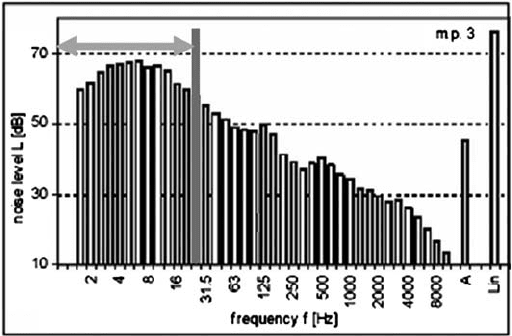
Wind Turbine Noise Measurements and Abatement Methods 645
Considering the nature of infrasound, it becomes apparent that downwind wind
turbines are more likely to produce signifi cant levels of infrasound levels. This is
because the tower–blade fl ow interaction creates air velocity instabilities that pro-
duce very low frequency acoustic waves called infrasound. Although downwind
wind turbines have been used in the past, the modern technology has moved away
from that noisy design to the upwind designs that give higher frequency noise
levels and therefore are less irritating for humans.
One example of low frequency sound and infrasound from a modern turbine is
shown in Fig. 3 .
Broadband noise is dominated by high frequencies greater than 100 Hz and it is
characterised by non-periodic signals that constitute an envelope that varies peri-
odically. A typical broadband signal is shown in Fig. 4 . Its main source of genera-
tion is the interaction of the wind turbine blades with atmospheric turbulence, and
also described as a characteristic "swishing" or "whooshing" sound.
To determine the relative importance of tone noise and broadband noise we
consider the narrow-band frequency spectrum of a signal. Figure 5 shows a typical
spectrum of tonal and broadband noise. At higher frequencies the broadband
random noise dominates the spectrum.
2.3 Mechanical generation of sound
A wind turbine consists of mechanical components that move or rotate in order to
capture the motion of the turbine and convert it to energy. Sources of such sounds
include:
Gearbox 1.
Generator 2.
Yaw drives 3.
Cooling fans 4.
Auxiliary equipment (e.g. hydraulics) 5.
Figure 3: Infrasound [ 2 ].
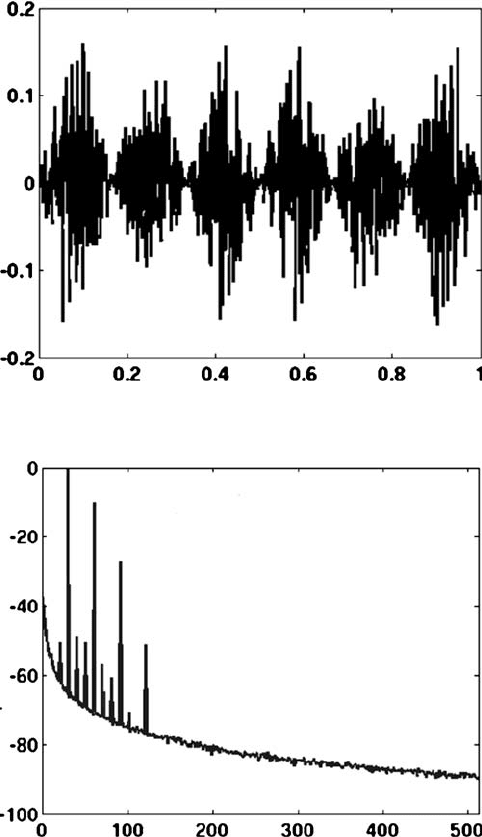
646 Wind Power Generation and Wind Turbine Design
Generally the mechanical sound is low frequency sound although it might have
a broadband component that comes from the relative motion from each of the
above parts. The turbine's metal parts come in contact with each other, such as the
generator, the gearbox and the shafts and they emit noise and as they vibrate.
Because wind turbines can have different constructions they might have differ-
ent sound emissions because of the way in which they operate. For instance they
may have blades which are rigidly attached to the hub or may have blades that can
Figure 4 : Broadband noise time spectrum.
Figure 5: Tonal and broadband frequency spectrum.
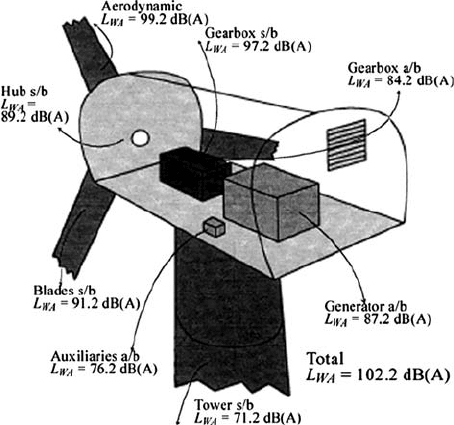
Wind Turbine Noise Measurements and Abatement Methods 647
be pitched (rotated around their long axis). Some have rotors that always turn at
a constant or near-constant speed while other designs might change the rotor
speed as the wind changes. Wind turbine rotors may be upwind or downwind of
the tower.
It is worth mentioning that the hub, rotor, and tower may act as loudspeakers,
transmitting the mechanical sound and radiating it. The transmission of noise from
the mechanical parts of a wind turbine can take place in two ways:
structure-borne •
air-borne •
Structure-borne sound [ 3 ] is a sound that is propagated through structures as
vibration and subsequently radiated as sound. The intensity and the frequency of
structure-borne sound depend on many factors such as the rotational speed of the
wind turbine, as well as the type and the material of the mechanical parts that
vibrate. Air-borne [ 4 ] means that the sound is directly propagated from the
component surface or interior into the air.
Structure-borne sound is transmitted along other structural components before it
is radiated into the air. For example, Fig. 6 shows the type of transmission path and
the sound power levels for the individual components for a 2 MW wind turbine. Note
that the main source of mechanical sounds in this example is the gearbox, which
radiates sounds from the nacelle surfaces and the machinery enclosure.
Utility scale turbines are usually insulated to prevent mechanical noise from
proliferating outside the nacelle or tower. Small turbines are more likely to produce
noticeable mechanical noise because of insuffi cient insulation.
Figure 6: Sound power levels of wind turbine components [ 1 ].
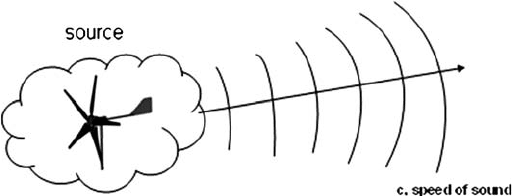
648 Wind Power Generation and Wind Turbine Design
3 S ound level
In order to understand how sound propagate we need to identify the nature of
sound. Sound is a series of waves and it is characterised by two properties: ampli-
tude (loudness) and frequency. Therefore there are sounds that consist of combi-
nations of low and high magnitude with low and high frequency. The human ear
can detect a very wide range of both sound levels and frequencies, but it is more
sensitive to some frequencies than others.
Sound is generated by numerous mechanisms and is always associated with
rapid small-scale pressure fl uctuations, which produce sensations in the human
ear. Sound waves are characterised in terms of their amplitude, wavelength (l ),
frequency ( f ) and speed c , as follows:
cfl=
(1 )
The speed of sound is a function of the medium through which it travels, and it
generally travels faster in more dense mediums. Sound propagates as a wave as
shown in Fig. 7 . In air it travels at a speed of 340 m/s and in water 1500 m/s. As
sound travels it transports acoustic energy with it which attenuates the further it
travels. As the sound propagates it disturbs the fl uid from its mean state.
The pressure at a position x is p = p
0
+ p′ ( x , t ) with p′ / p
0
<< 1.
Sound is measured in dB and the sound pressure level (SPL) is defi ned as
5
10 rms
SPL 20 log ( / 2 10 )dBp
−
=×
′
( 2)
where
rms
p
′
is the mean square level of fl uctuation [ 5 ].
As sound energy travels through the air, it creates a sound wave that exerts pres-
sure on receivers such as an ear drum or microphone and it makes our eardrums
vibrate [ 6 ]. Human whisper releases an acoustic power of 10
− 10
W and a large jet
transport at take off emits about 10 W.
The threshold of pain is between 130 and 140 dB. The threshold of hearing is
around 0 dB. The sound power level from a single wind turbine is usually between
90 and 105 dB(A). Figure 8 shows a few examples of sound pressure levels from
everyday life.
As described above, the decibel scale is logarithmic. A sound level measure-
ment that combines all frequencies into a single weighted reading is defi ned as a
Figure 7: Sound propagation.
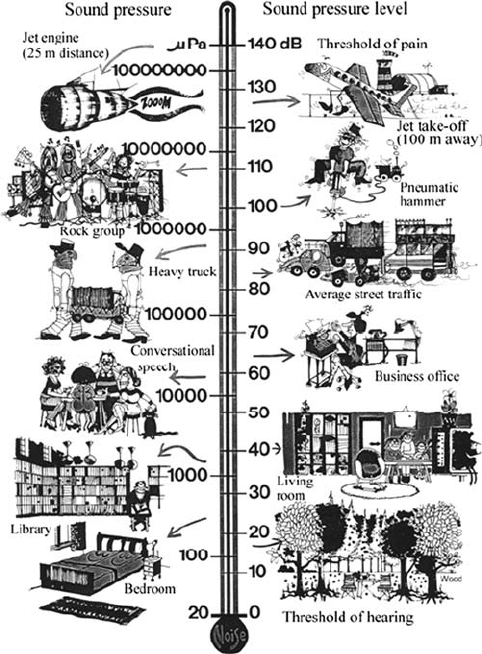
Wind Turbine Noise Measurements and Abatement Methods 649
broadband sound level. For the determination of the human ear's response to changes
in sound, sound level meters are generally equipped with fi lters that give less weight
to the lower frequencies. There are a number of fi lters that accomplish this:
A-weighting: This is the most common scale for assessing environmental and •
occupational noise. It approximates the response of the human ear to sounds of
medium intensity.
B-weighting: This weighting is not commonly used. It approximates the ear for •
medium-loud sounds, around 70 dB.
C-weighting: Approximates response of human ear to loud sounds. It can be •
used for low frequency sound.
G-weighting: Designed for infrasound .•
Details of these scales are discussed by Beranek and Ver [ 7 ].
Once the A-weighted sound pressure is measured over a period of time, it is
possible to determine a number of statistical descriptions of time-varying sound
Figure 8: Sound pressure levels examples [ 9 ].
650 Wind Power Generation and Wind Turbine Design
and to account for the greater community sensitivity to night-time sound levels [ 8 ].
Terms commonly used in describing environmental sound include:
L10, L50, and L90: The A-weighted sound levels that are exceeded 10%, 50%, •
and 90% of the time, respectively.
Leq: • Equivalent Sound Level: The average A-weighted SPL which gives the
same total energy as the varying sound level during the measurement period of
time.
Ldn: • Day-Night Level: The average A-weighted sound level during a 24-h day,
obtained after addition of 10 dB to levels measured in the night between
10 p.m. and 7 a.m.
4 Factors that affect wind turbine noise propagation
Propagation refers to how sound travels. Attenuation refers to how sound is
reduced by various factors. Many factors contribute to how sound propagates
and is attenuated, including air temperature, humidity, barriers, refl ections, and
ground surface.
The ability to hear a wind turbine also depends on the ambient sound level. When
the background sounds and wind turbine sounds are of the same magnitude, the
wind turbine sound gets lost in the background. The most important factors are:
Source characteristics (directivity, height) •
Distance of the source from the observer •
Air absorption •
Ground effects (refl ection and absorption on the ground) •
Weather effects (wind speed, temperature, humidity) •
Shape of the land – land topology •
4.1 Source characteristics
The source characteristics such as height and directivity can affect the sound prop-
agation path and its power or intensity. The higher a source is located, the higher
the sound power loss rate is. This means that wind turbine that is mounted on a
tower relatively high to a residential estate it has relatively low noise impact on
the residents as the sound energy attenuates until it reaches the human ear. The
directivity of an acoustic source has also a signifi cant impact on the sound per-
ceived by the human ear. For example when the sound is forced to follow a certain
directional path determined by the geometrical shape it is placed in, such as coni-
cal speaker, the radiation fi eld is concentrated towards a certain area leaving quite
zones in the opposite direction.
In general, as sound propagates without obstruction from a point source, the
initial sound energy decreases and it is being distributed over a larger and larger
area as the distance from the source increases.

Wind Turbine Noise Measurements and Abatement Methods 651
For example, in the case of spherical excitation or a monopole noise source the
sound is radiated in all directions and the sound level is reduced by 6 dB for each
doubling of distance from the source.
A moving train is a line source , and it emits equal sound power output per unit
length of the train line. A line source produces cylindrical spreading, resulting in a
sound level reduction of 3 dB per doubling of distance. The spherical propagation
is associated with the three-dimensional propagation and the line source with the
one-dimensional sound wave propagation, respectively. When two monopole
sources of equal strength but opposite phase are put together at a short distance
they produce a dipole, which is referred as two-dimensional sound wave propagation.
Figure 9 shows the sound directivities of a monopole and a dipole.
4.2 Air absorption
Air absorption of sound is driven by two mechanisms: molecular relaxation
and air viscosity. Molecular relaxation is the transition of a molecule from an
excited energy level to another excited level of lower energy. High frequencies
are absorbed more than low because they have short wave length and therefore
the waves dissipate as they travel through the air molecules. The air absorption
must be taken into account at high frequencies when calculating the reverberation
time of a room. It is due to friction between air particles as the sound wave travels
through the air. The amount of absorption depends on the temperature and humidity
of the atmosphere [ 10 ].
4.3 Ground absorption
The ground can contribute to the sound attenuation by two mechanisms sound
absorption and sound refl ection. When the sound hits the ground the acoustic
energy loss depends on the refl ection coeffi cient of the surface. On hard surfaces
attenuation occurs due to the acoustic energy losses on refl ection while on porous
surfaces, sound levels are being reduced due to the increased absorption of the
ground. High frequencies are generally attenuated more than low frequencies.
The refl ection coeffi cient depends on the impedance of the two media, in this
case, air and ground, and represents the absorbency of the ground in a homogeneous
Figure 9: (a) Monopole; (b) dipole.
(a) (b)
652 Wind Power Generation and Wind Turbine Design
way, i.e. the entire infi nite plane is assigned with the same refl ection
coeffi cient [ 11 ].
When the source and receiver are both close to the ground, the sound wave
refl ected from the ground may interfere destructively with the direct wave. This
effect (called the ground effect [ 12 ]) is normally noticed over distances of several
meters and more, and in the frequency range of 200–600 Hz.
4.4 Land topology
The topology and the shape of the land can signifi cantly affect the magnitude and
the direction of sound. For example, trees and high altitude vegetation can contrib-
ute to the sound attenuation. However, a long series of trees several hundreds of
meters long is required in order to achieve signifi cant attenuation.
Also signifi cant attenuation can be achieved by the use of natural or artifi cial
barriers or obstacles such as hills and buildings that exist on the ground. The level
of impact on the sound reduction of an obstacle depends on whether it is high
enough to obscure the ‘line of sight’ between the noise source and receiver.
Due to their short wavelength, high frequencies are trapped by the obstacles
preventing them from travelling far, unlike the low frequencies.
Similarly to the ground refl ection theory, the material of the barriers plays a
dominant role in the sound propagation and this is the reason barriers are often
used for noise treatment purposes [ 13 ]. A barrier is most effective when placed
either very close to the source or to the receiver.
4.5 Weather effects, wind and temperature gradients
The wind and the temperature can affect the propagation of the sound in the atmos-
phere under certain weather conditions. The mean uniform wind fl ow determines
the background noise levels and it alters the sound pressure downwind and upwind.
When a wind is blowing there will always be a wind gradient. A wind gradi-
ent results in sound waves propagating upwind being ‘bent’ upwards and those
propagating downwind being ‘bent’ downwards.
The temperature is another factor that affects sound radiation however; it
becomes important only when the high temperature gradients occur. Such dra-
matic changes in the temperature profi le are unlikely to happen in the atmosphere
close to the ground but they can occur at high altitude layers. Any temperature dif-
ferences in the atmosphere can cause local variations in the sound speed since the
latter depends on the temperature of the gas. Higher temperatures produce higher
speeds of sound. When sound waves are propagating through the atmosphere and
meet a region of non-uniformity, some of their energy is re-directed into many
other directions. This phenomenon is called refraction [ 14 ].
5 Measurement techniques and challenges
As we have already mentioned in previous sections, low frequency noise emis-
sions from wind turbines have given rise to health effects to neighbours. Resident
Wind Turbine Noise Measurements and Abatement Methods 653
complaints about the irritating noise from the wind turbines has led scientists and
engineers to invent ways to assess the levels of noise in the near and in the far fi eld
and eventually close to dwellings where residents live.
Measuring noise from wind turbines is not an easy task due to the fact that back-
ground noise levels increase as the wind speed increases. So, as the wind turbines
start rotating the background noise levels are being intensifi ed. Also when we
think that the wind turbines are placed outdoors where trees, leaves and vegetation
in general, are present then it becomes apparent that the background noise is com-
parable to the noise emissions from the turbines. This makes it extremely diffi cult
to measure sound from wind turbines accurately. At wind speeds around 8 m/s and
above, it generally becomes a quite abstruse issue to discuss sound emissions from
modern wind turbines, since background noise will generally mask any turbine
noise completely.
To assess the potential levels of infrasound and low frequency noise around a
wind farm and at neighbouring locations of interest, the measurements are under-
taken using a measuring system capable of capturing frequencies from 1 Hz to
20 kHz. Measurements are performed at internal and external locations placing the
microphones at locations where noise is considered more audible when occurred.
Assuming that the appropriate equipment is being used and the calibration proce-
dures have been followed, the standard procedure to take noise measurements is
the following:
Ambient background noise levels evaluation . •
Spot measurements of noise levels inside dwellings subject to access or prediction •
if access is prohibited.
Exterior acoustic measurements at neighbouring facades to assess annoyance. •
Spot measurements of wind speed. •
The evaluation and reporting of measurements made. •
It is worth mentioning that there is a variety of sophisticated model available but
they are all at developing stages. A typical time history of measured sound pressure
levels is shown in Fig. 10 .
5.1 For small wind turbines .
Our experience indicates that in practice, fi eld measuring is a challenging task
not only due to the diffi culty to estimate background levels but also due to the
complexity of the required experimental set up. One has to count for the direc-
tional noise emission depending on which side the wind is blowing and the fact
that modern small wind turbines rotate around their vertical axis making the noise
measurement techniques even more demanding.
Because of the importance of background noise in determining the acceptability
of the overall noise level, it is crucial to measure the background ambient noise
levels for all the wind conditions in which the wind turbine will be operating.
Sound propagation is a function of the source sound characteristics (direction and
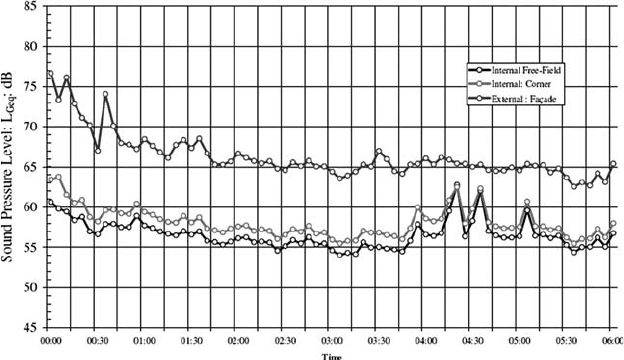
654 Wind Power Generation and Wind Turbine Design
height), distance, air absorption, refl ection and absorption and weather effects
such as changes of wind speed and temperature with height.
Given the current situation diffi culties, a good idea to tackle with such a prob-
lem would be at a fi rst stage to use the anechoic chamber to remove background
noise and depending on the results, to employ measurement techniques and meth-
ods which enable characterisation of the noise emission from wind turbines at a
receptor location. The use of a vertical board mounted with a microphone sug-
gested in the document of IEA [ 16 ] recommended practices in case of such a
problem. The document recommends the use of a large vertical board with a
microphone at the designated position with its diaphragm fl ushed with the board
surface or to suppress wind induced noise on a microphone. Figure 11 shows the
background noise levels and the noise levels from a wind turbine in operation.
6 Abatement methods
In principle there are two ways to reduce noise: either make the source less noisy
or make the receiver more sound proof. The same principle can be applied to the
wind turbines when considered as noise sources.
Also if we think the factors that affect the noise propagation we can easily guess
a few measures we can take in order to control noise from wind turbines. More
specifi cally locating wind farms as far and as high as possible from residential
areas and improving the sound insulation in houses we can signifi cantly limit the
sound levels received by the human ears. Natural obstacles and vegetation can also
prevent noise from reaching people’s homes.
A systematic and scientifi c consideration of all those factors along with real
time measurements leads to a study known as environmental impact assessment.
Such assessment is essential to evaluate the current environmental conditions at a
Figure 10: Time history of measured sound pressure levels [ 15 ].
